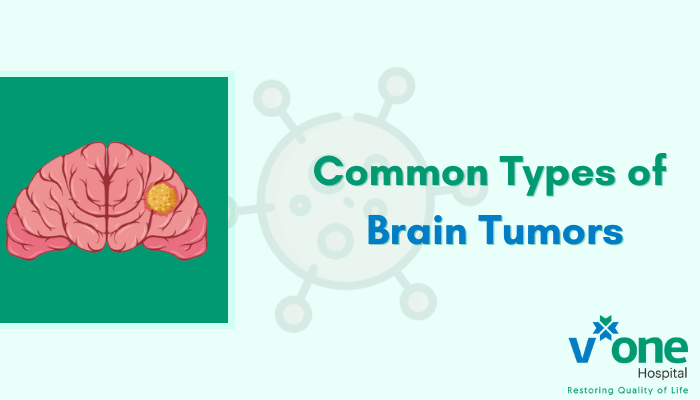Common Types of Brain Tumors | Brain Cancer Treatment Options
A brain tumor is a mass or growth of abnormal cells in your brain. Some of these are benign (non-cancerous), while others are malignant (cancerous).
Types of Brain Tumors
Depending on their location and the kind of cells they are made of, there are over 130 different types of brain tumors. In this blog, we will discuss some of the most common ones:
Primary Brain Tumors
Primary brain tumors originate in the brain or in nearby tissues, like the meninges, cranial nerves, and pituitary or pineal glands. When normal cells develop mutations in their DNA, the mutations instruct them to grow and rapidly divide, and to continue living when the healthy cells die. This forms a mass of abnormal cells, which is what we call a tumor.
1. Gliomas
A glioma is a brain tumor occurring in the brain and the spinal cord. There are types of gliomas, like astrocytomas, ependymomas, glioblastomas, oligoastrocytomas, and oligodendrogliomas. Gliomas account for 78% of malignant brain tumors.
2. Meningiomas
Meningiomas are (usually) non-cancerous tumors that originate in the membranes around the brain and the spinal cord. These are primary central nervous system tumors and it isn’t clear what causes them.
3. Acoustic Neuromas
Acoustic Neuromas are benign tumors that develop on the nerves that go from the inner ear to the brain, that control balance, and hearing. These are also called vestibular schwannomas, and they usually grow slowly or not at all, and only sometimes grow rapidly.
4. Pituitary Adenomas
Pituitary adenomas are non-cancerous tumors that develop in the pituitary gland, at the base of the brain. These tumors don’t spread beyond the skull but can affect the pituitary hormones and affect the whole body.
5. Medulloblastomas
Medulloblastomas are cancerous brain tumors that start in the lower back of the brain or the spinal cord and usually spread through the spinal fluid. These are most common in children but can affect anyone.
6. Germ Cell Tumors
Germ cell tumors are cancerous or non-cancerous tumors that happen in the testicles or the ovaries, and occasionally in other areas like the abdomen, brain, and chest. These growths of cells form from reproductive cells.
7. Craniopharyngiomas
These are rare but benign brain tumors that usually form near the pituitary gland and the hypothalamus, and they don’t spread to other parts of the brain or the body.
Secondary Brain Tumors
Secondary/metastatic brain tumors originate elsewhere in the body and spread to the brain. Cancers of the breast, colon, kidney, lung, and melanoma commonly spread to the brain, but any kind of cancer can do that. More adults get secondary brain tumors than primary.
Malignant Brain Tumors
A malignant brain tumor is a cancerous tumor that rapidly spreads to other areas of the brain and spine. Most of these are secondary cancers, starting elsewhere and spreading to the brain.
Grades of Brain Tumors
Brain tumors are generally graded from 1 to 4 depending on how fast they grow and how likely they are to grow back after treatment.
While benign tumors usually grade 1 or 2, malignant tumors are grade 3 or 4.
Brain Cancer Treatment
All brain cancers are tumors, but not all brain tumors are cancer. Depending on factors like tumor type, location, size, and the patient’s age and health, there are a few treatment options available for a cancerous brain tumor. Brain tumors are usually treated with surgery, radiation therapy, and chemotherapy.
Your specific treatment plan can involve several doctors, like neurosurgeons, oncologists, and radiation oncologists apart from your primary doctor.
1. Brain Cancer Surgery
A cancerous brain tumor is usually removed with surgery. Through craniotomy, a neurosurgeon removes a piece of the skull, exposing the brain, and tries to extract the whole tumor before placing the piece back and sewing the scalp together. If that’s not possible, he will remove as much as he can without damaging the brain tissue. This reduces the pressure on the brain, and then the rest of the tumor can be treated with radiation therapy or chemotherapy. Some tumors can’t be removed and may need a biopsy to identify the type. Another option is neuroendoscopy, where the surgeon makes a small hole in the skull or goes through the nose or mouth, and uses small tools (and sometimes, a real-time camera) to remove the tumor.
2. Radiation Therapy
Radiotherapy uses high-powered rays to damage cancer cells and stop their growth. This is an option when the tumor can’t be removed with surgery, when surgery isn’t possible, or to kill remaining cancer cells after surgery. It can be given as external radiation, internal radiation, or stereotactic radiosurgery.
3. Chemotherapy
Chemotherapy is the use of a drug or a combination of drugs to kill cancer cells. These drugs can be given orally or injected into a muscle or a blood vessel.
These were the different types of brain tumors, their grades, and treatment options for brain cancer. Get a consultation from a Senior Neurosurgeon with 17+ years of experience at V-One Hospital, Indore.

